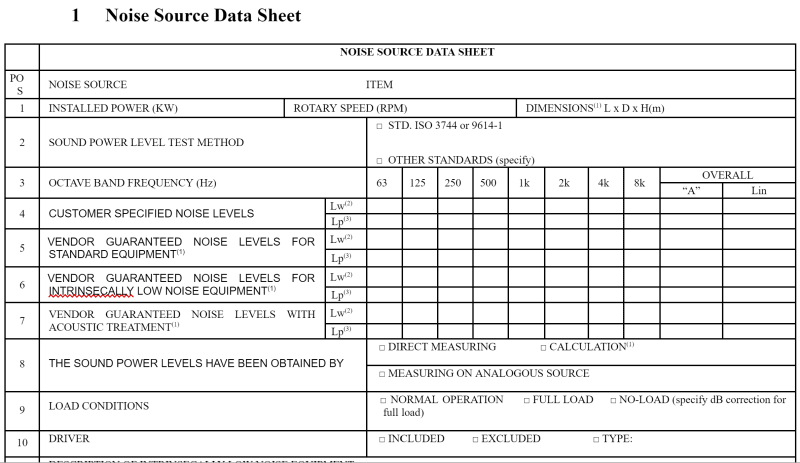hirschaplin
Petroleum
Hello,
Over the years, I have participated in a number of tenders for the supply of rotating machinery to various EPC contractors pretty much all over the world.
Nowadays, machinery noise level seems more important than ever. I guess mainly due to more stringent regulatory requirements pushing operators to ensure better field working conditions for their employees.
This is a bit problematic as we are required to guarantee machinery sound level @ 1 meter, typically the value has to be below 85 dBA or even less. More often than not we are also requested to accurately provide complete noise data for the product we offer. This is done by filling of the EPC company's standard noise data sheet table, something like this:

The product typically consist of a skid with a compressor driven by a motor either DOL or through a VFD. The compressor normally requires several utility systems with several small pumps and motors as well.
The problem is that the supply is 100% bespoke to each and every project. Even if it would be the same compressor model as supplied before, there is a big chance that there is a different material or that the process is different. Or that piping has another material or schedule (wall thickness) etc. There are so many factors that would affect the noise data...
Typically vendors of motors, compressors and pumps only provide simple noise data such as Sound pressure level Lp(A) xxx dB(A) and especially during bid phase. Let say we are able to obtain the following data:
Motor Lp(A) 82 dB(A)
Compressor Lp(A) 99 dB(A)
Utility pump Lp(A) 75 dB(A)
Utility motor Lp(A) 70 dB(A)
How can I use this simple data to calculate the mean/average sound of the complete skid with those items operating at the same time and how can I use that simple information to fill in the datasheet?
How are we expected to fill out such a data sheet for a bespoke skid during the bid phase and without possibility to measure until completion at final testing? What is the correct approach to handle / reply to such a request from a major EPC company?
Over the years, I have participated in a number of tenders for the supply of rotating machinery to various EPC contractors pretty much all over the world.
Nowadays, machinery noise level seems more important than ever. I guess mainly due to more stringent regulatory requirements pushing operators to ensure better field working conditions for their employees.
This is a bit problematic as we are required to guarantee machinery sound level @ 1 meter, typically the value has to be below 85 dBA or even less. More often than not we are also requested to accurately provide complete noise data for the product we offer. This is done by filling of the EPC company's standard noise data sheet table, something like this:

The product typically consist of a skid with a compressor driven by a motor either DOL or through a VFD. The compressor normally requires several utility systems with several small pumps and motors as well.
The problem is that the supply is 100% bespoke to each and every project. Even if it would be the same compressor model as supplied before, there is a big chance that there is a different material or that the process is different. Or that piping has another material or schedule (wall thickness) etc. There are so many factors that would affect the noise data...
Typically vendors of motors, compressors and pumps only provide simple noise data such as Sound pressure level Lp(A) xxx dB(A) and especially during bid phase. Let say we are able to obtain the following data:
Motor Lp(A) 82 dB(A)
Compressor Lp(A) 99 dB(A)
Utility pump Lp(A) 75 dB(A)
Utility motor Lp(A) 70 dB(A)
How can I use this simple data to calculate the mean/average sound of the complete skid with those items operating at the same time and how can I use that simple information to fill in the datasheet?
How are we expected to fill out such a data sheet for a bespoke skid during the bid phase and without possibility to measure until completion at final testing? What is the correct approach to handle / reply to such a request from a major EPC company?
